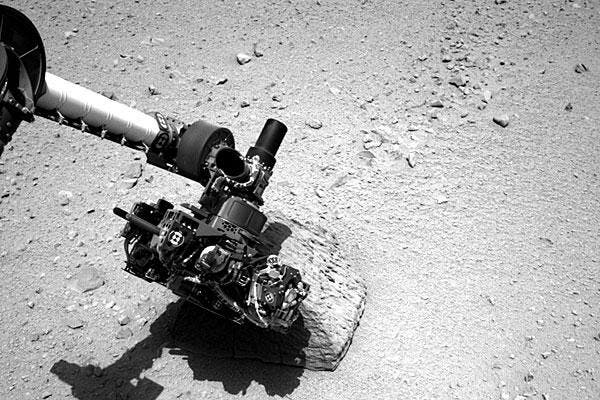Considering how long has passed since Curiosity landed on the Red Planet, it was about time the rover started mingling with martian rocks. Its first stop was ‘Jake’.
Martian geology and Curiosity‘s equipment

Curiosity rover stepped down from its crystal palace and made contact with one of the Martian beauties – in other words, for the first time, Curiosity reached out and made personal contact with a Martian rock. NASA had already decided what its first checkpoint will be: the rock named Jake Matijevic, after a legendary JPL engineer who passed away recently.
“In the last few days, the rover has been analyzing Jake Matijevic,” said Ashwin Vasavada, a member of the project. “After searching for a few days, we found this rock that had all the characteristics necessary to cross-compare the measurements from our arm-mounted instruments with those of the mast-mounted instruments.”
The contact was made during Curiosity‘s 46th day on Mars; the rover used its robotic arm and made contact using its Alpha Particle X-Ray Spectrometer (APXS), which was used for a closer inspection of the rock. NASA had limited expectations regarding its research value, the opportunity being regarded rather as an opportunity to test the technical equipment, including the robotic arm, the hand lens, and the X-ray spectrometer.
Moving on to more interesting things
NASA hasn’t given that much info regarding the scientific information extracted from the test, but they made it quite clear the test worked out just fine. After performing the analysis, Curiosity traveled a record 138 feet, the biggest distance traveled in a single day after the landing. Its next destination is a location nicknamed Glenelg, an area that satellite images indicate may be a junction between three types of geological terrain. The rover search for suitable soil to scoop up and analyze with its mobile laboratory.
“These near-term objectives will help us get ready for our first major science target, the light-toned fractured unit at Glenelg,” Vasavada said. “We hope to reach there within the next month or two.”
As I mentioned earlier, three different types of terrain meet at Glenelg, and researchers already have their eyes on one of them; as it turns out, one type which is very light toned stores up daily heat well into the night, with no apparent explanation.
Was this helpful?



